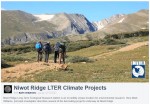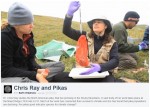The Niwot Ridge (NWT) Long Term Ecological Research (LTER) site is an unusual laboratory high in the Rocky Mountains. Year-round, scientists and field technicians are conducting numerous experiments to understand how the fragile ecosystems function and how they might be reacting to certain climate and nutrient disturbances. Several NWT researchers have decided to share a representative selection of these studies, showing the depth and breadth of LTER science in the alpine environment. The two videos were produced for NWT by Ryan Vachon of the nonprofit "Earth Initiatives" (http://www.earth-initiatives.org/) for about US$3,000 each.
The first video, Niwot Ridge LTER Climate Projects, features Mark Williams, the Principal Investigator of NWT and Professor at the University of Colorado, Boulder (CU), summarizing (in 9 minutes) over 50 years of NWT research on the dynamics of snow and the plants, animals and processes dependent on snow. Diverse projects from hydrology to plant competition are highlighted in interviews with Morgan Zeliff (graduate student, CU), Jennifer Morse (climate technician, NWT), Kurt Chowanski (climate technician, NWT), Emily Farrer (graduate student, University of California, Berkley).
Chris Ray says pikas respond to snow conditions
Alpine regions are far removed from where most people live. Some might think that this means that changes in these locations don’t impact us. However, in the Rocky Mountains region humans get about half their fresh water from alpine snowmelt. Determining long-term trends in snowpack is essential, but very difficult to do. Chris Ray, a research scientist at the University of Colorado at Boulder and NWT, hypothesizes that certain small mammals, pikas, which live in high elevation boulder fields, need this snow as much as we do. The snow insulates them during the winter months and recharges sub-surface water features that keep pikas cool in the summer months. In the second video, Chris Ray and Pikas, Ray argues that without adequate snow cover, pikas may disappear. Ray and her students Jennifer Wilkening and Liesl Erb are examining whether pikas could present another tool for monitoring one of the world’s most precious resources, water.

 Enlarge this image
Enlarge this image
